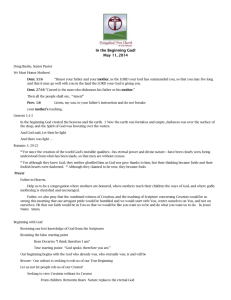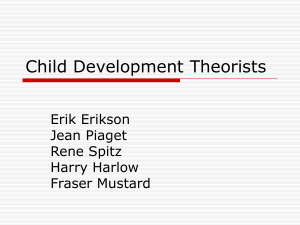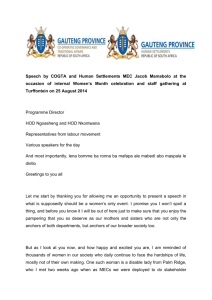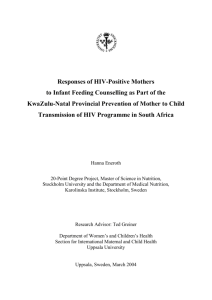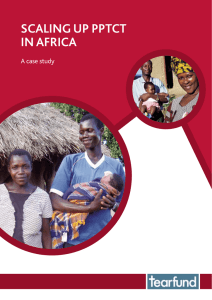Preparation, bacterial contamination and nutrient composition of
advertisement
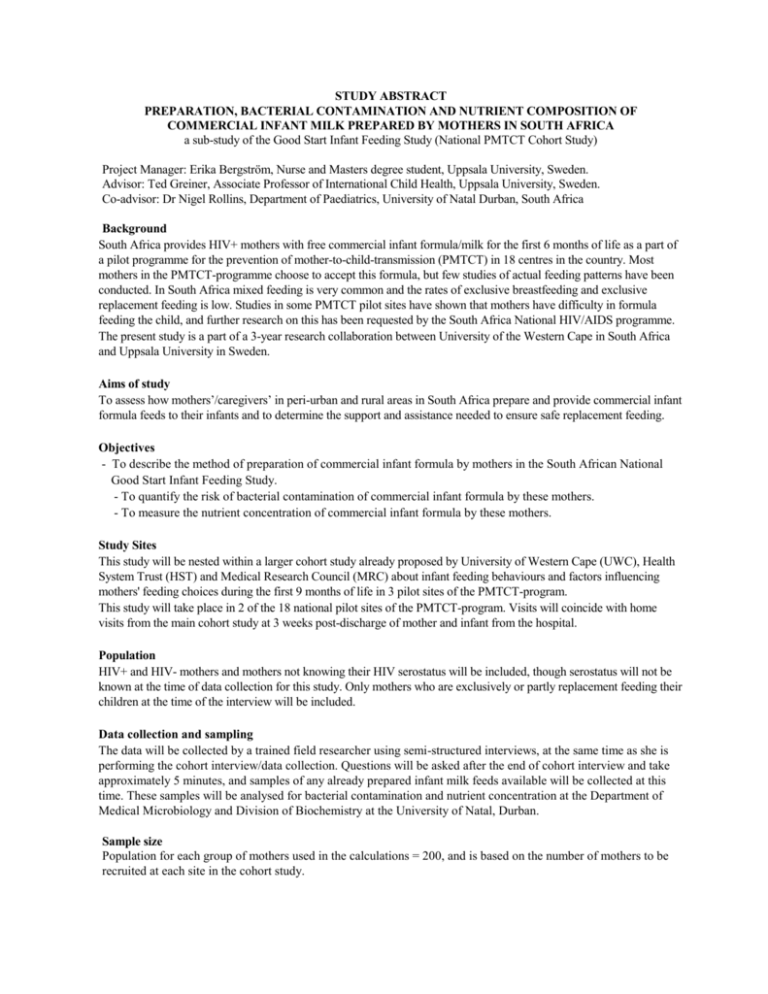
STUDY ABSTRACT PREPARATION, BACTERIAL CONTAMINATION AND NUTRIENT COMPOSITION OF COMMERCIAL INFANT MILK PREPARED BY MOTHERS IN SOUTH AFRICA a sub-study of the Good Start Infant Feeding Study (National PMTCT Cohort Study) Project Manager: Erika Bergström, Nurse and Masters degree student, Uppsala University, Sweden. Advisor: Ted Greiner, Associate Professor of International Child Health, Uppsala University, Sweden. Co-advisor: Dr Nigel Rollins, Department of Paediatrics, University of Natal Durban, South Africa Background South Africa provides HIV+ mothers with free commercial infant formula/milk for the first 6 months of life as a part of a pilot programme for the prevention of mother-to-child-transmission (PMTCT) in 18 centres in the country. Most mothers in the PMTCT-programme choose to accept this formula, but few studies of actual feeding patterns have been conducted. In South Africa mixed feeding is very common and the rates of exclusive breastfeeding and exclusive replacement feeding is low. Studies in some PMTCT pilot sites have shown that mothers have difficulty in formula feeding the child, and further research on this has been requested by the South Africa National HIV/AIDS programme. The present study is a part of a 3-year research collaboration between University of the Western Cape in South Africa and Uppsala University in Sweden. Aims of study To assess how mothers’/caregivers’ in peri-urban and rural areas in South Africa prepare and provide commercial infant formula feeds to their infants and to determine the support and assistance needed to ensure safe replacement feeding. Objectives - To describe the method of preparation of commercial infant formula by mothers in the South African National Good Start Infant Feeding Study. - To quantify the risk of bacterial contamination of commercial infant formula by these mothers. - To measure the nutrient concentration of commercial infant formula by these mothers. Study Sites This study will be nested within a larger cohort study already proposed by University of Western Cape (UWC), Health System Trust (HST) and Medical Research Council (MRC) about infant feeding behaviours and factors influencing mothers' feeding choices during the first 9 months of life in 3 pilot sites of the PMTCT-program. This study will take place in 2 of the 18 national pilot sites of the PMTCT-program. Visits will coincide with home visits from the main cohort study at 3 weeks post-discharge of mother and infant from the hospital. Population HIV+ and HIV- mothers and mothers not knowing their HIV serostatus will be included, though serostatus will not be known at the time of data collection for this study. Only mothers who are exclusively or partly replacement feeding their children at the time of the interview will be included. Data collection and sampling The data will be collected by a trained field researcher using semi-structured interviews, at the same time as she is performing the cohort interview/data collection. Questions will be asked after the end of cohort interview and take approximately 5 minutes, and samples of any already prepared infant milk feeds available will be collected at this time. These samples will be analysed for bacterial contamination and nutrient concentration at the Department of Medical Microbiology and Division of Biochemistry at the University of Natal, Durban. Sample size Population for each group of mothers used in the calculations = 200, and is based on the number of mothers to be recruited at each site in the cohort study. Site 1; peri-urban: Calculated with the assumption that 50% of the mothers from formal settlements, with a precision of +/-10%, and confidence interval of 95%, will not prepare the feeds within a satisfactory margin of safety concerning bacterial contamination, the required sample size is 65. For informal settlements, with the assumption of 70%, +/-10%, the required sample size is 57. Site 2; rural poor: Based on the same calculation as for site 1, informal settlements, required sample size is 57. Data entry, analysis and report Data will be entered and analysed using SPSS. Associations between socio-economic status, contamination, concentration and procedures that can contribute to microbiological contamination and incorrect concentrations will be explored using chi-square analysis and simple logistic regression models. Outcome It is hoped that this study will provide information that can be used in assisting health workers who counsel formula-feeding mothers to reduce errors in preparation. If possible, a simple, sensitive and specific algorithm will be developed to identify which mothers are most likely not to be able to formula feed safely (a first step towards an evidence base for risk assessment, that is, advising mothers on which feeding approach is likely to lead to the best outcome for their child).



